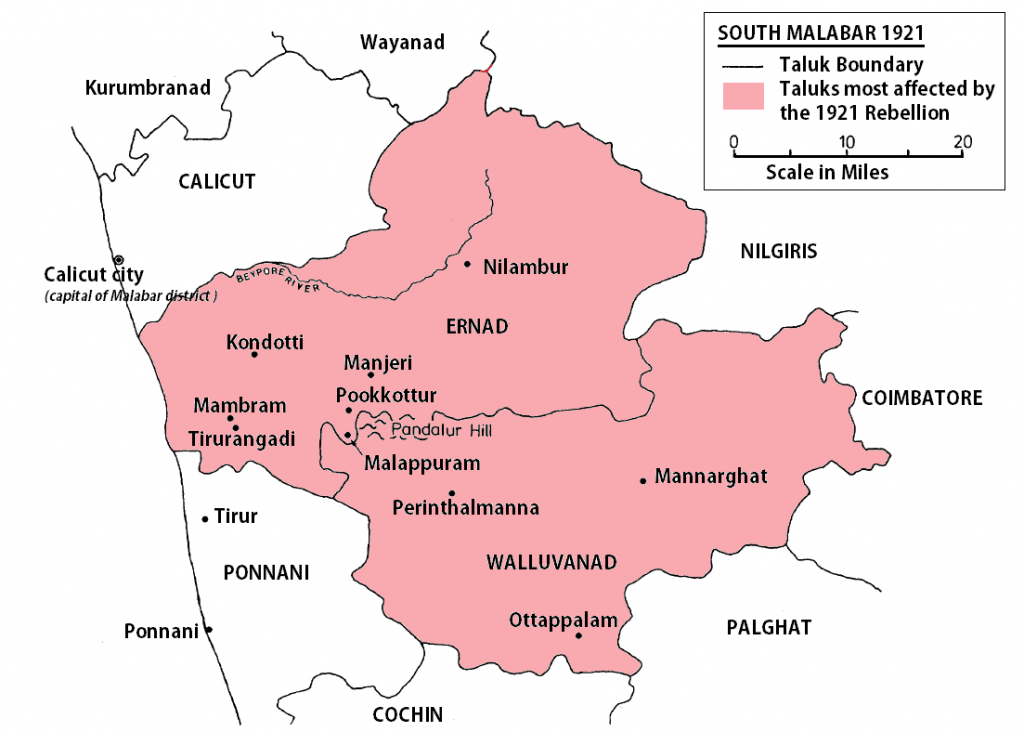Context:
- Recently, RSS leader at a meeting to commemorate the victims of the rebellion, had stated that the movement was one of the first manifestations of the Taliban mindset in India and it was later reported that Malabar Rebellion leaders Variamkunnath Kunhamed Haji, Ali Musaliar and 387 other “Moplah martyrs” will be removed from the Dictionary of Martyrs of India’s Freedom Struggle.
- However, a three-member committee appointed by the Indian Council of Historic Research (ICHR) to review the entries in the ‘Dictionary of Martyrs: India’s Freedom Struggle (1857-1947)’ is understood to have left the martyrs of the Left movement untouched and Martyrs of the communist movement of Kerala will remain as freedom fighters in the annals of India’s struggle for independence
- August 20, 2021, marks the centenary (100 years) of the Malabar rebellion, which is also known as the Moplah (Muslim) riots.
Relevance:
GS-I: History (Modern Indian History, Indian National Movement)
Dimensions of the Article:
- About the Malabar Rebellion (Moplah/Mappila riots)
- Reasons for the Moplah/Mappila riots
- Split in views regarding the Malabar Rebellion and the Controversies
About the Malabar Rebellion (Moplah/Mappila riots)
- The Malabar rebellion of 1921 (also known by the names Moplah riots, Mappila riots) happened from August 20, 1921 to 1922 in the Malabar region of Kerala.
- It started as a resistance against the British colonial rule in Malabar and soon, it was also a revolt against the prevailing feudal system in Kerala controlled by elite Hindus. (The British had appointed high caste Hindus in positions of authority to get their support, this led to the protest turning against the Hindus.)
- The main leaders of the rebellion were Ali Musliyar, Variankunnath Kunjahammad Haji, Sithi Koya Thangal, Chembrasery Thangal, K. Moideenkutti Haji, Konnara Thangal, Pandiyatt Narayanan Nambeesan, and Mozhikunnath Brahmadathan Nambudiripad.
- There were a series of clashes between the Mappila peasantry and their landlords, supported by the colonial government, throughout the 19th and early 20th centuries.
- In the initial stages, the movement had the support of Mohandas Gandhi and other Indian nationalist leaders, and a number of clashes took place between Khilafat volunteers and other religious communities, but the violence soon spread across the region.
- At the time, the Indian National Congress repudiated the movement and it remained isolated from the wider nationalist movement.
- By the end of 1921, the rebellion was crushed by the British who had raised a special battalion, the Malabar Special Force for the riot.
- In November 1921, 67 Moplah prisoners were killed when they were being transported in a closed freight wagon from Tirur to the Central Prison in Podanur. They died of suffocation. This event is called the Wagon Tragedy.

Reasons for the Moplah/Mappila riots
- The trigger of the uprising came from the Non-Cooperation Movement launched by the Congress in 1920 along with the Khilafat agitation.
- The anti-British sentiment fuelled by these agitations affected the Muslim Mapillahs (also known as Moplahs) of south Malabar region of Kerala.
- After the death of Tipu Sultan in 1799 in the Fourth Anglo-Mysore War, Malabar had come under British authority as part of the Madras Presidency. The British had introduced new tenancy laws that tremendously favoured the landlords known as Janmis and instituted a far more exploitative system for peasants than before.
- Most of the landlords were Namboodiri Brahmins while most of the tenants were Mapillah Muslims. Fuelled by the fiery speeches by Muslim religious leaders and anti-british sentiments, the Mopillahs launched a violent rebellion. Numerous actions of violence were reported and series of persecutions were committed both against the British and the Hindu landlords.
Split in views regarding the Malabar Rebellion and the Controversies
- Contemporary colonial administrators and modern historians differ markedly in their assessment of the incident, debating whether the revolts were triggered off by religious fanaticism or agrarian grievances.
- However, some contemporary Indian evaluations now view the rebellion as a national upheaval against colonial rule and the most important event concerning the political movement in Malabar during the period.
- It has often been perceived as one of the first nationalist uprisings in southern India. It has even been described as a peasant revolt. In fact, in 1971, the then Kerala government had included the participants of the rebellion in the category of freedom fighters.
- The riots, which had led to the deaths of hundreds of Hindus in the Malabar region, still remains a debated topic among historians. The current central government said that history was distorted, and the Malabar uprising, which began as part of the Khilafat Movement, ended up with the massive killings of Hindus.
- A review report of 2016 noted that “almost all the Moplah outrages were communal. They were against the Hindu society and done out of sheer intolerance.” The report also said that none of those who died in the Wagon Tragedy were freedom fighters of India as they hoisted the Khilafat flag and established Khilafat and Khilafat courts for a brief period.
-Source: The Hindu, Indian Express





